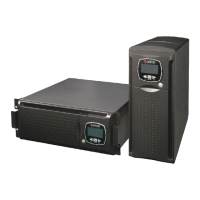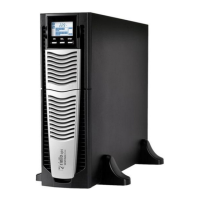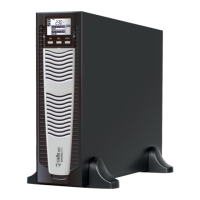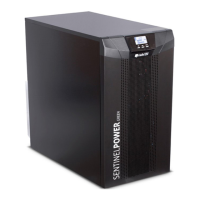- 34 -
Faults: These are more critical problems compared to the “Anomalies”, as if they persist they may bring the CPS to
a halt even in a very short time.
CODE DESCRIPTION
F01 Internal communication error
F03
Phase1 input fuse blown
F09 Precharge of positive branch condensers failed
F10 Precharge of negative branch condensers failed
F11 BOOST stage anomaly
F14 Inverter Phase1 sine curve distorted
F17 Inverter stage anomaly
F19 Positive battery overvoltage
F23 Output overload
F26 Phase1 output relay locked (will not open)
F29 Phase1 output fuse broken or output relay locked (will not close)
F32 Battery charger stage anomaly
F33 Battery measures error
F34 Heat sink overtemperature
F37 Battery charger overtemperature
F39 VDC Bus measures error
F40 Fan failure
F41 Redundant Bypass failure
Locks: these codes indicate that the CPS, or one of its parts, is locked. Usually, they are preceded by an alarm signal.
In case of faults and consequent locking of the inverter, the latter will be turned off and the load will be powered via
the bypass line (this procedure is excluded for locks caused by serious and persistent overloads and for those caused
by a short circuit).
CODE DESCRIPTION
L01 Incorrect auxiliary power supply
L02 One or more internal cables disconnected
L03 Phase1 input fuse broken
L06 BOOST stage overvoltage positive
L07 BOOST stage overvoltage negative
L08 BOOST stage undervoltage positive
L09 BOOST stage undervoltage negative
L10 Static bypass switch fault
L11 L1 bypass output locked
L14 Phase1 inverter overvoltage
L17 Phase1 inverter undervoltage
L20 Continuous voltage at inverter output or Sine curve of Phase1 inverter distorted
L23 Phase1 output overload
L26 Short circuit at Phase1 output
L34 Phase1 heat sink overtemperature
L37 Battery charger overtemperature
L38
Temperature probe 1 damaged
L39 Temperature probe 2 damaged
L41 Battery charger temperature probe damaged
L49 Inverter capacitor damaged
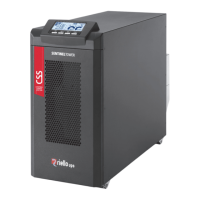
